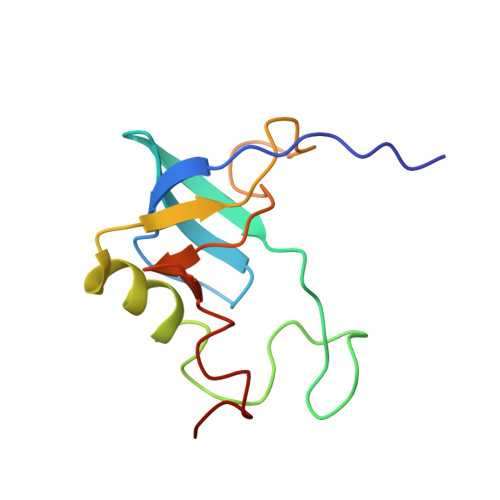Folding stability and cooperativity of the three forms of 1-110 residues fragment of staphylococcal nuclease
Xie, T., Liu, D., Feng, Y., Shan, L., Wang, J.F.(2007) Biophys J 92: 2090-2107
- PubMed: 17172296
- DOI: https://doi.org/10.1529/biophysj.106.092155
- Primary Citation of Related Structures:
1RKN, 2F3V, 2F3W - PubMed Abstract:
Folding stability and cooperativity of the three forms of 1-110 residues fragment of staphylococcal nuclease (SNase110) have been studied by various biophysical and NMR methods. Samples of G-88W- and V-66W-mutant SNase110, namely G-88W110 and V-66W110, in aqueous solution and SNase110 in 2.0 M TMAO are adopted in this study. The unfolding transitions and folded conformations of the three SNase fragments were detected by far- and near-ultraviolet circular dichroism and intrinsic tryptophan fluorescence measurements. The tertiary structures and internal motions of the fragments were determined by NMR spectroscopy. Both G-88W and V-66W single mutations as well as a small organic osmolyte (Trimethylamine N-oxide, TMAO) can fold the fragment into a native-like conformation. However, the tertiary structures of the three fragments exhibit different degrees of folding stability and compactness. G-88W110 adopts a relatively rigid structure representing a most stable native-like beta-subdomain conformation of the three fragments. V-66W110- and TMAO-stabilized SNase110 produce less compact structures having a less stable "beta-barrel" structural region. The different folding status accounts for the different backbone dynamic and urea-unfolding transition features of the three fragments. The G-20I/G-29I-mutant variants of the three fragments have provided the evidence that the folding status is correlated closely to the packing of the beta-strands in the beta-barrel of the fragments. The native-like beta-barrel structural region acts as a nonlocal nucleus for folding the fragment. The tertiary folding of the three fragments is initiated by formation of the local nucleation sites at two beta-turn regions, I-18-D-21 and Y-27-Q-30, and developed by the formation of a nonlocal nucleation site at the beta-barrel region. The formation of beta-barrel and overall structure is concerted, but the level of cooperativity is different for the three 1-110 residues SNase fragments.
- National Laboratory of Biomacromolecules, Center for Structural and Molecular Biology, Institute of Biophysics, Chinese Academy of Sciences, Beijing 100101, People's Republic of China.
Organizational Affiliation:
















